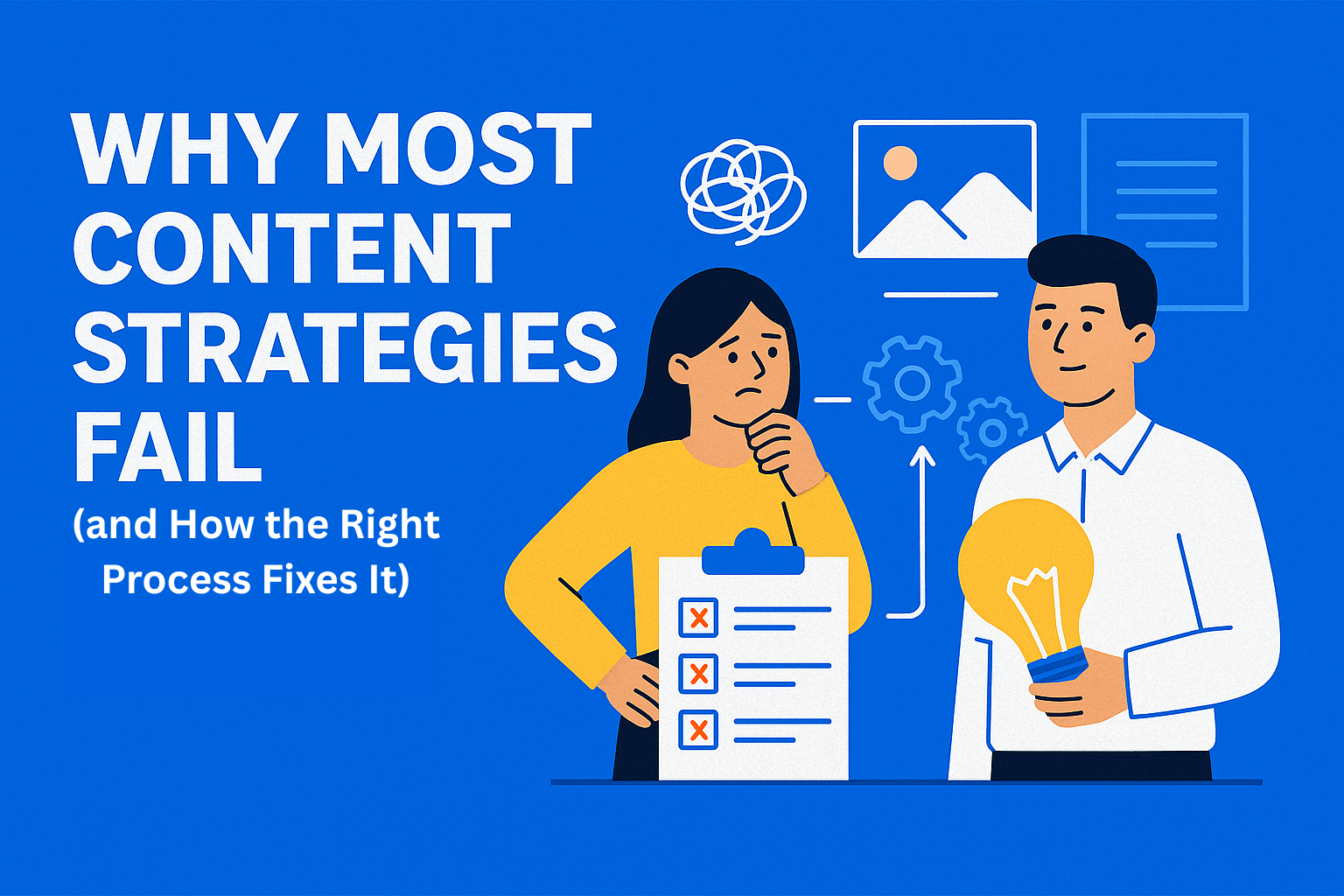Why Most Content Strategies Fail (and How the Right Process Fixes It)
Most content strategies fail not because of bad ideas, but because of broken processes. Discover how clear workflows, accountability, and smart tracking turn scattered content efforts into consistent, measurable success

Most companies don’t fail because they have bad ideas - they fail because they don’t have a clear process that turns those ideas into results. You might have great ideas, a strong team, and the desire to succeed, but without structure, everything can fall apart. In this article, we’ll simply explain why many content strategies don’t work and how the right process can make a big difference.
Key Takeaways
- Lack of process is the #1 reason strategies fail - without order, even strong ideas never make it to publication.
- Accountability drives progress - clear roles (writer, editor, manager, analyst) keep content moving smoothly.
- Quantity doesn’t beat quality - fewer, purposeful pieces outperform a flood of weak, forgettable posts.
- The right process links strategy to action - goals, tools, and measurement turn “plans on paper” into real results.
- Improvement is continuous - reviewing, adjusting, and refining the workflow ensures long-term content success.
Why Most Content Strategies Don’t Work
Inconsistent Workflows
One of the most common reasons for failure is inconsistent workflows. Many companies start with a plan but quickly get lost in everyday chaos. There are no clearly defined steps from idea to publication, so tasks overlap, get lost, or are delayed.
Imagine a team that has ten great blog ideas, but no one knows who will write them, who will approve them, or who will publish them. As a result, nothing gets out on time, and the audience forgets the brand even exists.
A consistent content process ensures that every step is clear and everyone knows their role. When the process works, the team spends less time on organization and more on creation.
Lack of Accountability and Ownership
Another reason for failure often lies in a lack of accountability. In many teams, task division is unclear. Everyone works on everything, so no one feels truly responsible for the final outcome.
When there are no clearly defined roles at each stage (idea, writing, editing, publishing), focus and energy are lost. People work hard, but without direction. In such conditions, a content strategy cannot grow because there’s no clear ownership of the process.
To fix this, every role must be defined. Someone is responsible for generating ideas, someone for execution, and someone for measuring results. Only then does the process become stable.
Strategy Not Connected to Execution
Another common mistake: the strategy exists on paper but has no connection to real tasks. The team has a document with goals, but those goals aren’t translated into concrete actions.
For example, if the goal is to increase brand awareness, that must be turned into specific tasks - how many blogs, what topics, which distribution channels. Without that connection, the content strategy remains just an idea, not a plan.
Focus on Quantity, Not Quality
Many teams think that publishing more means being more successful. But that’s not true. If you create a lot of low-quality content, your audience will quickly get tired and lose trust.
If you don’t track results and don’t know what actually works, you’re creating blindly. Instead of publishing ten weak articles a month, it’s better to have three high-quality ones that align with your strategy.
This is where the real power of a good process shows - it brings quality, consistency, and measurable results.
How the Right Process Changes the Game
Standardizing Workflows
The first step toward success is to standardize your workflow. That means every stage in the content creation process should have clear rules and order - from brainstorming and writing to editing, publishing, and promotion.
If you use tools like EasyContent, this process becomes much easier. Within the platform, you can assign roles and permissions to everyone involved in content creation. This way, everyone on the team knows what to do next and by when.
Standardization doesn’t kill creativity - it frees it. When there’s structure, the team doesn’t have to think about organization, only about ideas.
Clear Role Distribution
Once the process is clear, the next step is making sure everyone knows their role. Introduce the RACI model:
- Responsible - the person who performs the task,
- Accountable - the person who is ultimately responsible,
- Consulted - the one who provides expert input,
- Informed - the one who needs to stay updated.
When the team knows their part of the job, everything becomes simpler and smoother. There’s no confusion or frustration. Everyone knows what to do, and the team leader can easily track progress. This creates order and discipline that lead to real results.
Connecting Strategy and Metrics
Without measurement, there’s no progress. Every content strategy needs clear metrics. If you can’t measure success, you can’t improve it.
Set measurable goals: website visits, time spent on page, number of shares, inquiries, or sales. Then use tools like Google Analytics, HubSpot, or Ahrefs to track your results. Based on the data, adjust your process.
A good process is not just about organization - it’s about the connection between goals and data. This helps you see what works and repeat it.
Continuous Improvement
A process is never finished. It must evolve. Introduce regular analysis and feedback. At the end of each campaign or quarter, the team should reflect on what worked and what didn’t.
Ask your team: What slowed us down? Where did we lose focus? How can we be faster and smarter next time? This approach builds a culture of learning and growth, not blame.
Constant improvement brings stability. When you regularly refine your process, results become more reliable and easier to measure.
Conclusion
In the end, the truth is simple: ideas matter, but the process brings them to life. Without a process, even the best content strategy stays just a nice plan on paper.
A good process brings:
- consistency,
- clarity,
- accountability,
- and measurable growth.
If you want your content to truly make an impact, start by defining your process. It’s the foundation that holds everything together. Once you set up a system that works, every next step becomes easier, faster, and more successful.
So, the next time your content strategy isn’t delivering results, don’t blame the ideas. Look at the process. Because the process is what makes the difference between chaotic effort and predictable success.






